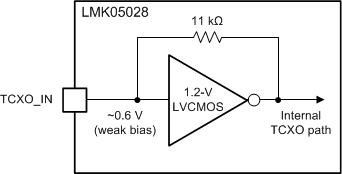ZHCSHN9A February 2018 – April 2018 LMK05028
PRODUCTION DATA.
- 1 特性
- 2 应用
- 3 说明
- 4 修订历史记录
- 5 说明 (续)
- 6 Pin Configuration and Functions
- 7 Specifications
- 8 Parameter Measurement Information
-
9 Detailed Description
- 9.1 Overview
- 9.2 Functional Block Diagrams
- 9.3
Feature Description
- 9.3.1 Oscillator Input (XO_P/N)
- 9.3.2 TCXO/OCXO Input (TCXO_IN)
- 9.3.3 Reference Inputs (INx_P/N)
- 9.3.4 Clock Input Interfacing and Termination
- 9.3.5 Reference Input Mux Selection
- 9.3.6 Hitless Switching
- 9.3.7 Gapped Clock Support on Reference Inputs
- 9.3.8 Input Clock and PLL Monitoring, Status, and Interrupts
- 9.3.9
PLL Channels
- 9.3.9.1 PLL Frequency Relationships
- 9.3.9.2 Analog PLL (APLL)
- 9.3.9.3 APLL XO Doubler
- 9.3.9.4 APLL Phase Frequency Detector (PFD) and Charge Pump
- 9.3.9.5 APLL Loop Filter
- 9.3.9.6 APLL Voltage Controlled Oscillator (VCO)
- 9.3.9.7 APLL VCO Post-Dividers (P1, P2)
- 9.3.9.8 APLL Fractional N Divider (N) With SDM
- 9.3.9.9 REF-DPLL Reference Divider (R)
- 9.3.9.10 TCXO/OCXO Input Doubler and M Divider
- 9.3.9.11 TCXO Mux
- 9.3.9.12 REF-DPLL and TCXO-DPLL Time-to-Digital Converter (TDC)
- 9.3.9.13 REF-DPLL and TCXO-DPLL Loop Filter
- 9.3.9.14 REF-DPLL and TCXO-DPLL Feedback Dividers
- 9.3.10 Output Clock Distribution
- 9.3.11 Output Channel Muxes
- 9.3.12 Output Dividers
- 9.3.13 Clock Outputs (OUTx_P/N)
- 9.3.14 Glitchless Output Clock Start-Up
- 9.3.15 Clock Output Interfacing and Termination
- 9.3.16 Output Synchronization (SYNC)
- 9.3.17 Zero-Delay Mode (ZDM) Configuration
- 9.3.18 PLL Cascading With Internal VCO Loopback
- 9.4 Device Functional Modes
- 9.5 Programming
- 9.6 Register Maps
- 10Application and Implementation
- 11Power Supply Recommendations
- 12Layout
- 13器件和文档支持
- 14机械、封装和可订购信息
9.3.2 TCXO/OCXO Input (TCXO_IN)
The TCXO input is the reference clock to the TCXO-DPLL loop in each PLL channel. When the PLL channel uses the TCXO-DPLL, the TCXO input source determines the close-in phase noise and wander performance (MTIE/TDEV) when the DPLL is locked, as well as the frequency accuracy and stability in free-run and holdover modes. A TCXO input with high phase noise floor should have minimal or no impact on the output jitter performance, provided the TCXO loop bandwidth is designed low enough to attenuate its noise contribution. This input can be driven from a low-frequency TCXO, OCXO, or external traceable clock that conforms to the frequency accuracy and holdover stability requirements of the application. TCXO and OCXO frequencies of 10 to 12.8 MHz are widely available and cost-effective options.
The TCXO input can accept an AC-coupled single-ended clock (sine, clipped-sine, or square wave) and has an internal weak bias of about 0.6 V. The input voltage swing should be less than 1.3 Vpp and terminated before AC-coupling to the pin. If unused, the TCXO input buffer can be powered down by register bit and the pin can be left floating.
The buffered TCXO path also drives the input monitoring blocks as well as the TCXO/Ref bypass mux to the output muxes, allowing a buffered copy of the TCXO input on OUT0 and/or OUT1.
 Figure 25. TCXO Input Buffer
Figure 25. TCXO Input Buffer